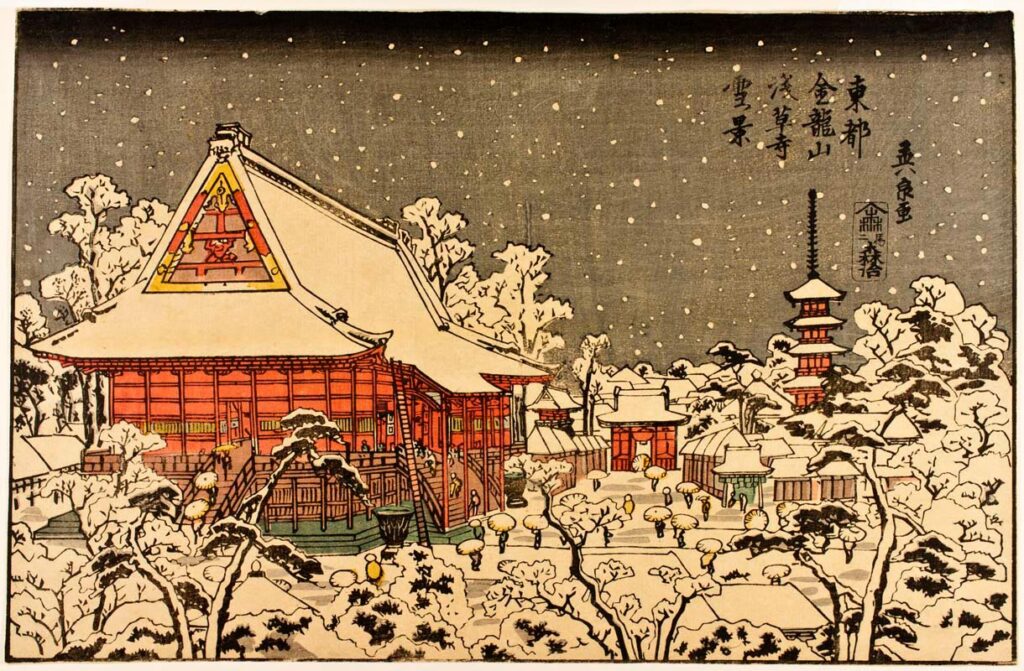
Title: Snow Scene at Senso-Ji Temple at Kinryuzan in the Eastern Capital
Creator: Keisai Eisen
Period: Edo
Date: Late 1830’s
Culture: Japan
Medium: woodblock print; ink and color on paper
Dimensions: 21 x 35 cm
Repository: Wetmore Print Collection, Art History Dept., Cummings Arts Center, Connecticut College, New London
Credit line: Gift of Prof. Caroline Black, Botany Dept., Connecticut College
ID number: slide# 0036; black060
Description
The Honden (Main hall) shown on the left of this print is the central part of the Sensō-ji Buddhist Temple. It features an irimoya, or “hip-and-gable roof,” which is characterized by a curved hip roof that slopes down on all four sides, with a triangular gable at either end of the ridgepole. The temple was erected in 645 CE making it the oldest one in Tokyo. It is still in use today although it had to be partially rebuilt following the second World War when the Honden was burnt down. The building embraces certain Japanese architectural aesthetics such as the structure being more horizontal as opposed to vertical, as well as it being constructed from wood. This allows the temple to hide amongst the trees from an aerial view and blend in with the surrounding environment.
The structure in the middle of the print is called the Kaminarimon (thunder gate) which marks the entrance to the temple. The multi-tiered tower on the right side of the print is called a five-storied pagoda. Pagodas can be defined by their square shape with each side representing a cardinal direction and their eaves protruding out far beyond the structure. Pagodas were used to house sacred scrolls and relics of Buddhism. They were often found in shrines and their distinct architectural features allude to religious connotations. Pagodas typically have an odd number of floors; this pagoda has five floors which could represent the five elements in the Buddhist universe (sky, wind, fire, water, earth). A sōrin is the finial protruding out of the top of a pagoda with a hemispherical bottom part, a series of disks along a central shaft, and a flame-shaped ornament and a jewel at the top, which have different symbolic meanings. The pagoda’s form was directly derived from the Indian stupa; they were similar in design and could house remains or religious artifacts. Wood is the principal material and the buildings are painted red, which was the usual practice for Buddhist architecture in Japan.
References
Keisai Eisen, Japanese. Snow Scene at Senso-Ji Temple at Kinryuzan in the Eastern Capital. color woodcut. Place: Wetmore Print Collection, Art History Dept, Cummings Arts Center, Connecticut College, New London, Donated by Prof. Caroline Black, Botany Dept, Connecticut College. https://library-artstor-org.peach.conncoll.edu/#/asset/CONNASIAN_106310617017 (access to Artstor required).
“Snow Scene at Senso-Ji Temple at Kinryuzan in the Eastern Capital.” Museum of Fine Arts, Boston, collections.mfa.org/objects/176464.
“Japanese Architecture – Buildings & Houses from Japan.” Architecture & Design, www.architectureanddesign.com.au/features/list/japanese-architecture-and-buildings#:~:text=%E2%80%9CTraditional%20Japanese%20architecture%E2%80%9D%20typically%20refers,much%20simpler%20than%20its%20European.
1 thought on “Snow Scene at Senso-Ji Temple at Kinryuzan in the Eastern Capital”